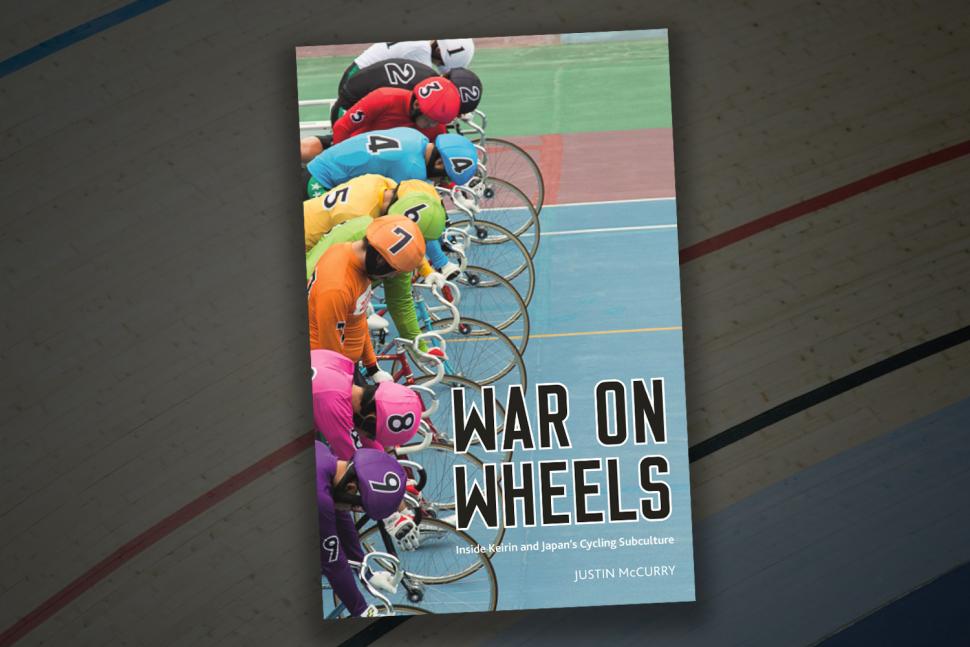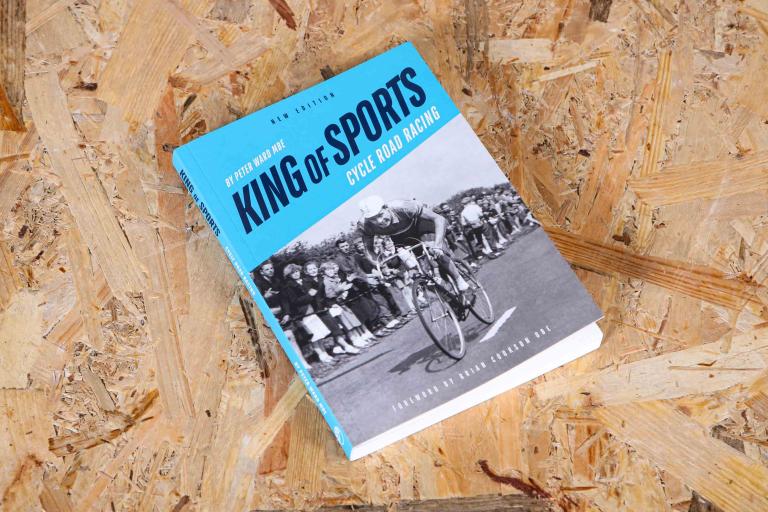- News
- Reviews
- Bikes
- Components
- Bar tape & grips
- Bottom brackets
- Brake & gear cables
- Brake & STI levers
- Brake pads & spares
- Brakes
- Cassettes & freewheels
- Chains
- Chainsets & chainrings
- Derailleurs - front
- Derailleurs - rear
- Forks
- Gear levers & shifters
- Groupsets
- Handlebars & extensions
- Headsets
- Hubs
- Inner tubes
- Pedals
- Quick releases & skewers
- Saddles
- Seatposts
- Stems
- Wheels
- Tyres
- Tubeless valves
- Accessories
- Accessories - misc
- Computer mounts
- Bags
- Bar ends
- Bike bags & cases
- Bottle cages
- Bottles
- Cameras
- Car racks
- Child seats
- Computers
- Glasses
- GPS units
- Helmets
- Lights - front
- Lights - rear
- Lights - sets
- Locks
- Mirrors
- Mudguards
- Racks
- Pumps & CO2 inflators
- Puncture kits
- Reflectives
- Smart watches
- Stands and racks
- Trailers
- Clothing
- Health, fitness and nutrition
- Tools and workshop
- Miscellaneous
- Buyers Guides
- Features
- Forum
- Recommends
- Podcast
review
 2021War on Wheels by Justin McCurry
2021War on Wheels by Justin McCurry£16.99
VERDICT:
An engagingly written in-depth explanation of keirin, showing why the version you normally see is a pastiche
Engagingly written
Reveals a little-known side of Japan and cycling
Would benefit from more pictures
Weight:
445g
Contact:
At road.cc every product is thoroughly tested for as long as it takes to get a proper insight into how well it works. Our reviewers are experienced cyclists that we trust to be objective. While we strive to ensure that opinions expressed are backed up by facts, reviews are by their nature an informed opinion, not a definitive verdict. We don't intentionally try to break anything (except locks) but we do try to look for weak points in any design. The overall score is not just an average of the other scores: it reflects both a product's function and value – with value determined by how a product compares with items of similar spec, quality, and price.
What the road.cc scores meanGood scores are more common than bad, because fortunately good products are more common than bad.
- Exceptional
- Excellent
- Very Good
- Good
- Quite good
- Average
- Not so good
- Poor
- Bad
- Appalling
With the close association between keirin and Japan, and the Olympic Games taking place in Tokyo this year, what better time to find out more about the race? War on Wheels may be about keirin, but not as we know it: the version we see on the world stage doesn't do justice to the sport as practised in Japan. It's a far more interesting story than you might expect, often in surprising ways.
One thing you learn early on from the author, Justin McCurry, the Guardian's Japan and Korea correspondent, is 'that Japanese keirin and its UCI counterpart have little in common besides their name'.
If you want to know about the rules of keirin for the Olympic Games or World Championships, then this book can certainly help you. However, to really appreciate the discipline you have to understand more about Japanese society, and its impact on so much of the sport – which is what this book also explains rather well.
I learn that a lot of the keirin experience could be summarised into a few words: gambling, rules, and tradition. And even more gambling.
The Japanese don't like to encourage betting, but the funds it raised at keirin races were invaluable in rebuilding the country's post-war economy. As a result, explains McCurry, 'keirin is not simply a sport; it is a communal act of state-sanctioned philanthropy, with its origins in the darkest days of Japan's modern history.'
It was the requirements of gambling that led to the use of a pacer, 'to ensure that the element of unpredictability was automatically built in to every keirin race…making betting a viable proposition.' UCI keirin keeps the pacer, if not the original reason for having one.
There's another thing that the UCI didn't adopt: in Japanese keirin, 'to avoid races descending into a simple sprint for the finish line as soon as the pacer's duties are done, riders must observe rules governing the timing of their final assault.' Each rider has a specific and pre-determined role, and that role dictates when they are allowed to start sprinting.
If the UCI were to introduce that rule it would make the viewing experience even harder to fathom for the average spectator, already baffled by the presence of a small motorbike on the track.
> Buyer’s Guide: 42 of the best cycling books
Tradition makes sure that 'keirin bikes are as far from cutting-edge as it's possible to imagine' – carbon fibre frames are occasionally wheeled out for the benefit of a world audience, but normally it's steel all the way – built to a narrowly defined specification.
It's a similar story for the components (including the toeclips and straps), where each of them has to be approved and stamped with 'NJS, or Nihon Jitensha Shinkokai, the forerunner of the present-day Japan Keirin Association'. Despite what some fixie riders might think, it is not a mark of superior quality, but rather is designed to ensure a level playing field, so that performance is down to the riders alone. It makes the UCI's rules on trying to limit any advantage from equipment seem half-hearted.
War on Wheels is described as 'the only full length book on keirin in English', but, as McCurry discovered, the situation is not much better in Japan, where he 'found evidence that keirin is a sport many Japanese would like to pretend doesn't exist'. He found there were only two books on offer 'at a cavernous book shop in central Osaka', and both were shelved in the section on gambling, not sport.
He fears that traditional keirin is 'facing an existential crisis', for reasons that range from a reluctance to break from tradition, to the male domination of both riders and gamblers, declining attendance and its associated betting – and more.
I tracked down one other book, from 1996, called Keirin by Kai-K Sawabe and Bertram Job. It's short, at 114 pages, with the main language of German accompanied by an English translation, but the majority of the pages feature large colourful images, many of them doing a good job of illustrating the regime and conditions that McCurry describes. War on Wheels, by contrast, has a scant eight pages of pictures, and in my view would have benefited from a few more. Keirin can lend itself to some stunning shots, as Keirin shows.
I had never been able to fathom the appeal of keirin – but that was based on watching the wrong sort. The more I learned about 'proper' keirin, the greater the respect I have for it, and I hope these games will lead to a greater interest in the home version from those watching overseas. For anyone who is interested, this book is perfectly timed and pitched to explain all.
Verdict
An engagingly written in-depth explanation of keirin, showing why the version you normally see is a pastiche
road.cc test report
Make and model: War on Wheels by Justin McCurry
Size tested: 320 pages
Tell us what the product is for and who it's aimed at. What do the manufacturers say about it? How does that compare to your own feelings about it?
From Pursuit:
The strange and thrilling world of Japanese track racing - a cycling and betting culture unlike anything else on earth
The Olympic cycling sport of keirin was invented in Japan more than 70 years ago to raise money to rebuild the country after World War II. Now, fans bet billions of dollars a year on races, with the top riders earning huge sums.
In each race, a pacemaker leads nine riders around huge concrete velodromes, then leaves the track with around a lap and a half to go - the cue for a frantic finish as the competitors reach speeds of up to 70 kph. Along the way they block and shove each other, clash heads and occasionally crash (the two Japanese characters used to write keirin mean 'battle' and 'wheel'). To prevent race fixing, the cyclists spend meets living in dorms, with no access to online technology. Their lives are ruled by ritual and fierce competition, from their rookie days at the Japan Keirin School near Mount Fuji to the annual Grand Prix final, whose winner takes home prize money of almost one million dollars.
A small number of foreign riders are invited to compete in Japan every year and some, like Shane Perkins, have overcome culture shock to prosper in the home of keirin. The Olympic version - which has made stars of Chris Hoy, Jason Kenny and Victoria Pendleton - is being taken more seriously in Japan as Tokyo prepares to host the 2021 Olympics and Paralympics.
Justin McCurry, the Guardian's Japan and Korea correspondent, explores a blue-collar Japan we rarely see and a uniquely fascinating sporting culture.
Tell us some more about the technical aspects of the product?
Title: War on Wheels
Author: Justin McCurry
Publisher: Pursuit
Date: 24/6/21
Format: Hardback
Pages: 320
ISBN: 9781788160858
Price: £16.99
Tell us what you particularly liked about the product
It's an unexpectedly interesting story.
Tell us what you particularly disliked about the product
The missed opportunity with pictures.
Did you enjoy using the product? Yes
Would you consider buying the product? Yes
Would you recommend the product to a friend? Yes
Use this box to explain your overall score
It's a thorough analysis of a topical race, written in an engaging style, making for an enjoyable read.
About the tester
Age: 60
I usually ride: My best bike is:
I've been riding for: Over 20 years I ride: Most days I would class myself as: Expert
I regularly do the following types of riding: touring, club rides, sportives, general fitness riding,




That's just the right size for a cycle route... BUT NO the car has to shine
Ok but that is of marginal if any relevance to this case.
I'm still running an ELMNT BOLT V1, and I've never really understood the LED's. I'm sure I configured them for HR zones, but never really look at...
Mostly agree. Although ... high level sport is complicated. It's not wrestling exactly, but there sometimes seems to be more than a little...
It would have been better to buy 1 lock for £200 or rather 250 for a hiplock or litelok.
It just seems a lot of trouble to go, doesn't it. If you are into building stuff like this perhaps some system where the vehicle brings you to...
Why is this not the will of god?
PKD foresaw it, though his novel was based on a different outcome of WWII, not the precursor to WWIII. Maybe the Idiocracy film is a closer fit?
@Sredlums: I'm not sure I follow your logic. If someone grabs your helmet twists it, then the reason it doesn't feel good is because the outer is...
Coming to the mid-paced Saturday club ride soon.